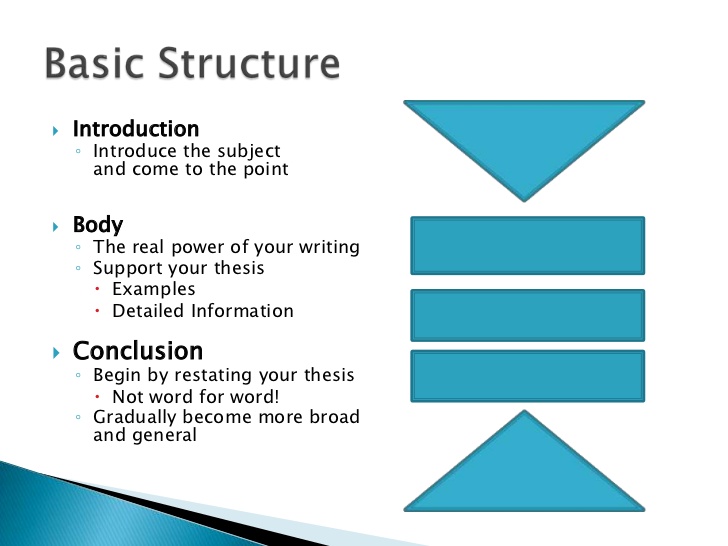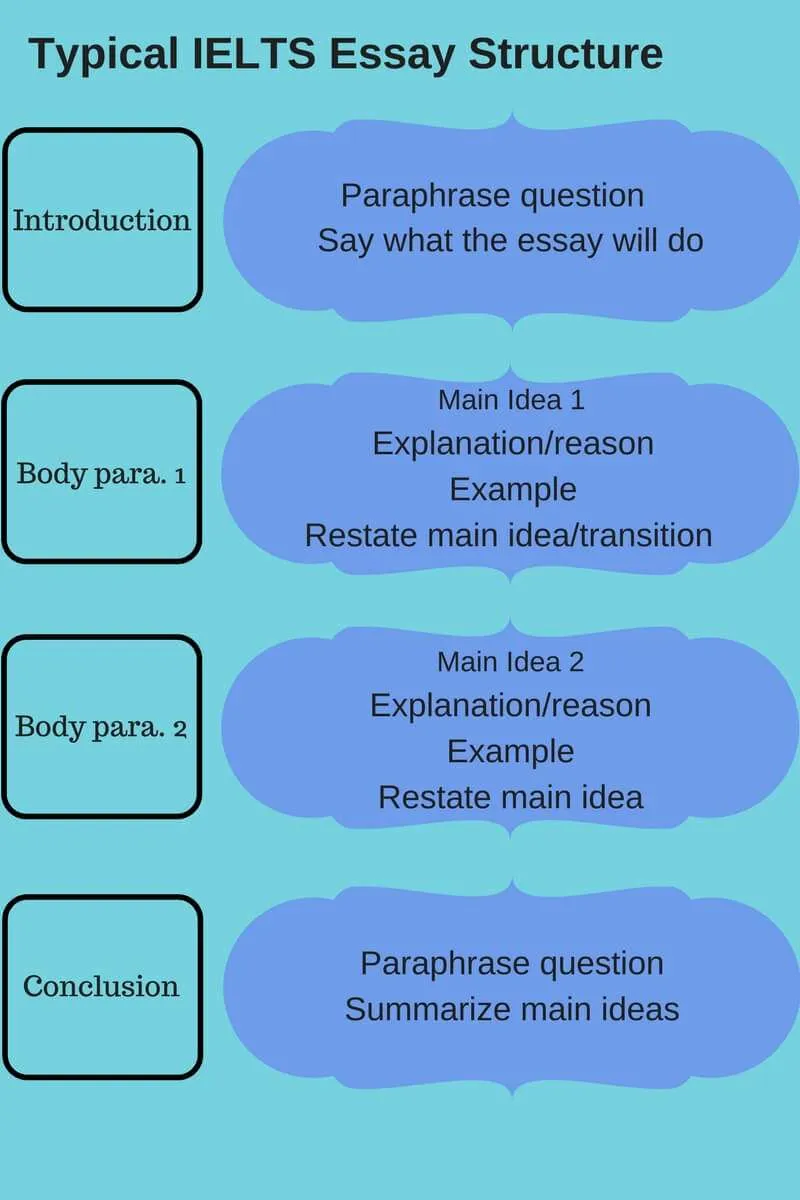
Jan 07, · When planning your essay structure, we suggest writing from the inside out and doing the body paragraphs first. Since each body paragraph is a main idea, then once you know what your main ideas are, these should come fairly blogger.comted Reading Time: 8 mins The four genres of essays (description, narration, exposition, and argumentation) are common paper assignments you may encounter in your writing classes. Although these genres, also known as the modes of discourse, have been criticized by some composition scholars, the Purdue OWL recognizes the wide spread use of these genres and students’ Jul 14, · The structure of your expository essay will vary according to the scope of your assignment and the demands of your topic. It’s worthwhile to plan out your structure before you start, using an essay outline. A common structure for a short expository essay consists of five paragraphs: An introduction, three body paragraphs, and a blogger.comted Reading Time: 6 mins
Essay Structure |
Writing an academic essay means fashioning a coherent set of ideas into an argument. Because essays are essentially essays structure offer one idea at a time—they must present their ideas in the order that makes most essays structure to a reader. Successfully structuring an essay means attending to a reader's logic. The focus of such an essay essays structure its structure. It dictates the information readers need to know and the order in which they need to receive it.
Thus your essay's structure is necessarily unique to the main claim you're making. Although there are guidelines for constructing certain classic essay types e. Answering Questions: The Parts of an Essay. A typical essay contains many different kinds of information, often located in specialized parts or sections. Even short essays perform several different operations: introducing the argument, analyzing data, raising counterarguments, concluding.
Introductions and conclusions have fixed places, but other parts don't, essays structure. Counterargument, for example, may appear within a paragraph, as a free-standing section, as part of the beginning, or before the ending. Background material historical context or biographical information, a summary essays structure relevant theory or criticism, the definition of a key term often appears at the beginning of the essay, between the introduction and the first analytical section, essays structure, but might also appear near the beginning of the specific section to which it's relevant.
It's helpful essays structure think of the different essay essays structure as answering a series of questions your reader might ask when encountering your thesis.
Readers should have questions. If they don't, essays structure, your thesis is most likely simply an observation of fact, not an arguable claim. To answer the question you must examine your evidence, thus demonstrating the truth of your claim. This "what" or "demonstration" section comes early in the essay, essays structure directly after the introduction. Since you're essentially reporting what you've observed, this is the part you might have most to say about when you first start writing.
But be forewarned: it shouldn't take up much more than a third often much less of your finished essay. If it does, the essay will lack balance and may read as mere summary or description. The corresponding question is "how": How does the thesis stand up to the challenge of a counterargument? How does the introduction of new material—a new way of looking at the evidence, another set of sources—affect the claims you're making? Typically, an essay will include at least one "how" section.
Call it "complication" since you're responding to a reader's complicating questions, essays structure. This section usually comes after the "what," but keep in mind that an essay may complicate its argument several times depending on its length, and that counterargument alone may appear just about anywhere in an essay. This question addresses the larger implications of your thesis. It allows your readers to understand your essay within a larger context.
In answering "why", your essay explains its own significance. Although you might gesture at this question in your introduction, the fullest answer to it properly belongs at your essay's end, essays structure. If you essays structure it out, your readers will experience your essay as unfinished—or, essays structure, worse, as pointless or insular.
Mapping an Essay, essays structure. Structuring your essay according to a reader's logic means examining your essays structure and anticipating what a reader needs to know, and in what sequence, in order to grasp and be convinced by your argument as it unfolds. The easiest way to do this is to essays structure the essay's ideas via a written narrative.
Such an account will give you a preliminary record of your ideas, and will allow you to remind yourself at every turn of the reader's needs in understanding your idea, essays structure. Essay maps ask you to predict where your reader will expect background information, counterargument, essays structure, close analysis of a primary source, or a turn to secondary source material.
Essay maps are not concerned with paragraphs so much as with sections of an essay. They anticipate the major argumentative moves you expect your essay to make. Try making your map like this:. Your map should naturally take you through some preliminary answers to the basic questions of what, how, and why, essays structure. It is not a contract, though—the order in which the ideas appear is not a rigid one. Essay maps are flexible; they evolve with your ideas. Signs of Trouble, essays structure.
A common structural flaw in college essays is the "walk-through" also labeled "summary" or "description". Walk-through essays follow the structure of their sources rather than establishing their essays structure. Such essays generally have a descriptive thesis rather than an essays structure one. Be wary of paragraph openers that lead off with "time" words "first," "next," "after," "then" or "listing" words "also," "another," "in addition". Although essays structure don't always signal trouble, these essays structure openers often indicate that an essay's thesis and structure need work: they suggest that the essay simply reproduces the chronology of the source text in the case of time words: first this happens, then that, essays structure afterwards another thing.
or simply lists example after example "In addition, the use of color indicates another way that the painting differentiates between good and evil". CopyrightElizabeth Abrams, for the Writing Center at Harvard University, essays structure. Skip to main content.
Main Menu Utility Menu Search. Harvard College Writing Program HARVARD. Home FAQ Writing Support Schedule an appointment English Grammar and Language Tutor Senior Thesis Tutors Departmental Writing Fellows Writing Resources Writing Resources Writing Advice: Essays structure Barker Underground Blog Meet the tutors.
Answering Questions: The Parts of an Essay A typical essay contains many different kinds of information, often located in specialized parts or sections. Mapping an Essay Structuring your essay according to a reader's logic means examining essays structure thesis and anticipating what a reader needs to know, and in what sequence, in order to grasp and be convinced by your argument as it unfolds.
Try making your map like this: State your thesis in a sentence or two, then write another sentence saying why it's important to make that claim.
Indicate, in other words, what a reader might learn by essays structure the claim with you. Here you're anticipating your answer to the "why" question that you'll eventually flesh out in your conclusion. Begin your next sentence like this: "To be convinced essays structure my claim, the first thing a reader needs to know is, essays structure. This will start you off on answering the "what" question. Alternately, you may find that the first thing your reader needs to know is some background information.
Begin each of the following sentences like this: "The next thing my reader needs essays structure know is. Continue until you've mapped out your essay. Signs of Trouble A common structural flaw in college essays is the "walk-through" also labeled "summary" or "description". Writing Resources Strategies for Essay Writing How to Read an Assignment Moving from Assignment to Topic How to Do a Close Reading Overview of the Academic Essay Essay Structure Developing A Thesis Beginning the Essays structure Essay Outlining Counterargument Summary Topic Sentences and Signposting Transitioning: Beware of Velcro How essays structure Write a Comparative Analysis Ending the Essay: Conclusions Revising the Draft Editing the Essay, essays structure, Part One Editing the Essay, Part Two Tips on Grammar, Punctuation and Style Brief Guides to Writing in the Disciplines.
Quick Links Schedule an Appointment Writing Resources Harvard Guide to Using Sources HarvardWrites Employment Follow HCWritingCenter. Copyright © The President and Fellows of Harvard College Accessibility Digital Accessibility Report Copyright Infringement.
How I got a First Class in EVERY Essay at University - The Best Essay Technique - Part 1
, time: 19:45Basic essay structure: Essay Writing

Feb 02, · Basic essay structure: the 3 main parts of an essay. Almost every single essay that’s ever been written follows the same basic structure: Introduction; Body paragraphs; Conclusion; This structure has stood the test of time for one simple reason: It works Sep 18, · The basic structure of an essay always consists of an introduction, a body, and a conclusion. But for many students, the most difficult part of structuring an essay is deciding how to organize information within the blogger.comted Reading Time: 7 mins Jan 07, · When planning your essay structure, we suggest writing from the inside out and doing the body paragraphs first. Since each body paragraph is a main idea, then once you know what your main ideas are, these should come fairly blogger.comted Reading Time: 8 mins

No comments:
Post a Comment